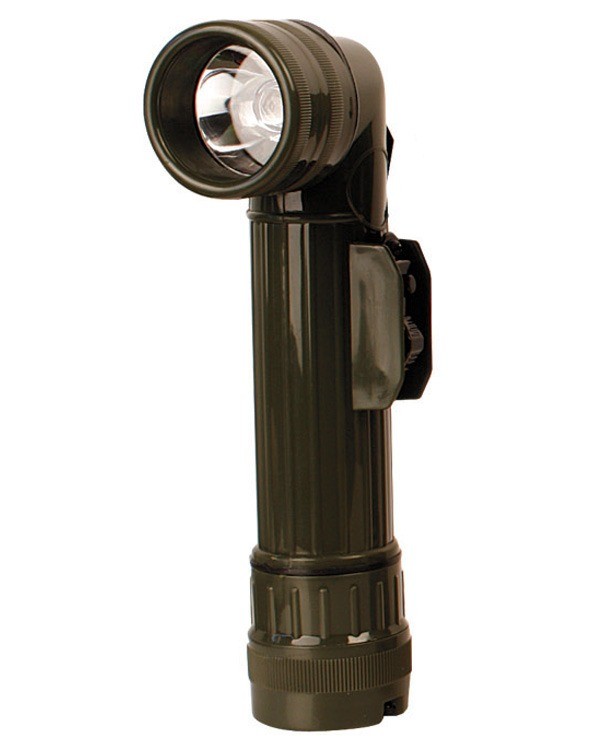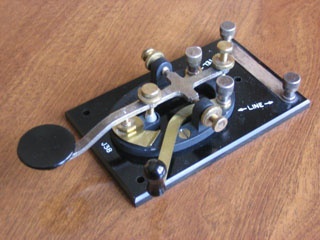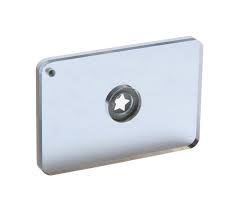Battlefield Communications Morse Code
By Dean Wayland
Introduction
Samuel F. B. Morse devised his famous code during the early 1840's for use with the new telegraphy (landline) technology, as well as lamps, heliographs and signal flags (Wig-Wag), but it would eventually also be employed with automatic systems such as telex or teletype, and even hand and arm signals. Today it is still taught and used by Special Forces and radio amateurs for use with radio. His original code later became known as American Morse and was extensively used by both sides throughout the American Civel War (1861~1865). However it was replaced almost immediately after the war, by the International version, which was an 1851 modification by the Europeans to solve some technical issues concerned with its use with underwater cables. This is the version that we know today as 'the Morse Code'.
The Tools
In CONTACT the Morse Code is used principly with flashlights (torches), and to a lesser degree with heliographs (mirrors), and hand and arm movements, but not yet with radio as this is restricted to licenced amateur radio operators only. Their main application is for use in issuing and responding to a challenge at distance. Because of this the required knowledge is much reduced as the operator only needs to master the ten digits, plus 7 letters A, H, K, O, R, S and V, which are used to create the procedural signs (Prosigns) that control the signalling process. Plus most people already know the letters O and S for the signal SOS.

|
Left: 'The' genuine NATO issue US Army right angle flashlight, which has remained in service for signalling, ever since its introduction during the Viet Nam war. The Fulton MX991/U comes fitted with a standard bulb, a sliding on/off switch and a flasher button for Morse Code, which has protective guards to prevent accidental activation. A screw on/off base stores a defuser lense, an amber, a red, a blue, a green and a white filter, plus a spare bulb. The front section unscrews to allow filters to be added or removed (I always leave the red over white filter in place to dim the output and avoid unwanted reflections), and it runs off 2 D cells. Available in olive drab, black and an indeterminate dark camouflage pattern from
Cadet Direct.
NB: there is now an LED bulb replacement kit, that includes a battery cradle for 2 AA cells, making the flashlight, much, much lighter to carry, while maintaining its effectiveness as a signal light. The reason for the lower power is so the LED doesn't melt the torch! The LED conversion kit is not yet available here in the UK, but I have made enquiries. The kit is available directly from the US maker
Fulton. Click image to enlarge.
|
|---|

|
Left: The J38 WWII era US military type telegraphy key, which are still in use with radio amateurs for the sending of Morse Code via radio. Although today fully electronic keys are more popular as they are easier and less stressful to use, and enable more accurate and much faster rates of transmission.
Right: The Star Flash Signalling Mirror. The 21st century survival heliograph, made by Ultimate Survival Technology, 76x51mm (2" x 3"), unbreakable and even floats. The technique to use it is simple; view the target via the centre hole, position yourself in relation to the sun so that in your reflection you can see a spot of light upon your own face. Now tilt the mirror so that the bright spot of light vannishes in to the centre hole. Each time this happens the person at the other end will see a flash of light - simple. Click image to enlarge, or visit
The Bushcraft Store and take a look.
|

|
About The Tables
In addition listed on the first and second tables between the letters, numbers and the Morse Code, are the phonetic expressions for each. The
NATO Phonetic Code is used in voice radio and in speech to provide clarity, to spell difficult words and for unit identification, and is therefore also vital to learn.
In the following tables the standard notation DI/DIT and DAH are used for the dots and dashes of the code, being the most proven and effective learning aid. For ease DI is used within a letter, while DIT is only used at the end of a letter. Think of DI as an abbreviated DIT.
Letters are composed of 1~4 flashes, while numbers always contain 5, and punctuation marks always have 6. Procedural signs (Prosigns) consist of between 3 and 10 flashes each.
The relationship between the DIT, the DAH, and any spaces, is as follows;
-
The DIT should be as short a flash as you can reasonably manage with your flashlight.
-
One DAH is equal in length to three DITs
-
The space between the parts of the same letter should be equal to one DIT.
-
The space between two letters of the same word should be equal to three DITs (that is one DAH).
-
The space between two words should be equal to five to seven DITs (approx. 2 DAHs).
As a guide the average transmission speed is twelve words per minute, real experts can exceed twenty. Six is a good minimum.
On-Line Visual Learning Aid
Below are 7 links to a series of visual learning aids intended for teaching the use of Morse Code with flashlights for maritime service. They are listed in ascending order of difficulty.
|
1. Numbers
|
2. E, H, I, M, O, S, T.
|
3. A, B, D, N, U, V.
|
4. C, G, J, K, P, W.
|
|
5. F, L, Q, R, X, Y, Z.
|
6. Complete A ~ Z
|
7. Random
|
Letters
Letters consist of between 1 and 4 flashes only.
Each letter in the table below is followed by its phonetic rendering, after which comes its Morse versions.
|
Letter
|
Expression
|
Morse Sound
|
Signal
|
|
A
|
ALPHA
|
DI DAH
|
|
|
B
|
BRAVO
|
DAH DI DI DIT
|
|
|
C
|
CHARLIE
|
DAH DI DAH DIT
|
|
|
D
|
DELTA
|
DAH DI DIT
|
|
|
E
|
ECHO
|
DIT
|
|
|
F
|
FOXTROT
|
DI DI DAH DIT
|
|
|
G
|
GOLF
|
DAH DAH DIT
|
|
|
H
|
HOTEL
|
DI DI DI DIT
|
|
|
I
|
INDIA
|
DI DIT
|
|
|
J
|
JULIET
|
DI DAH DAH DAH
|
|
|
K
|
KILO
|
DAH DI DAH
|
|
|
L
|
LIMA
|
DI DAH DI DIT
|
|
|
M
|
MIKE
|
DAH DAH
|
|
|
N
|
NOVEMBER
|
DAH DIT
|
|
|
O
|
OSCAR
|
DAH DAH DAH
|
|
|
P
|
PAPA
|
DI DAH DAH DIT
|
|
|
Q
|
QUEBEC
|
DAH DAH DI DAH
|
|
|
R
|
ROMEO
|
DI DAH DIT
|
|
|
S
|
SIERRA
|
DI DI DIT
|
|
|
T
|
TANGO
|
DAH
|
|
|
U
|
UNIFORM
|
DI DI DAH
|
|
|
V
|
VICTOR
|
DI DI DI DAH
|
|
|
W
|
WHISKY
|
DI DAH DAH
|
|
|
X
|
X-RAY
|
DAH DI DI DAH
|
|
|
Y
|
YANKEE
|
DAH DI DAH DAH
|
|
|
Z
|
ZULU
|
DAH DAH DI DIT
|
|
|
|---|
Numbers
Numbers always have 5 flashes ONLY.
Following each digit is its phonetic expression. NB: the numbers 3, 4 and 5 have an alternate expression which is used when transmission conditions are very poor, as they aid in inturpretation. FYI some operators use the letter "N" to represent 9, and a single long DAH to represent 0. While in UNSGC service do not do this, use the correct form ONLY.
|
Number
|
Expression
|
Morse Sound
|
Signal
|
|
1
|
ONE
|
DI DAH DAH DAH DAH
|
|
|
2
|
TWO
|
DI DI DAH DAH DAH
|
|
|
3
|
THREE or TREE
|
DI DI DI DAH DAH
|
|
|
4
|
FOUR or FOWER
|
DI DI DI DI DAH
|
|
|
5
|
FIVE or FIFE
|
DI DI DI DI DIT
|
|
|
6
|
SIX
|
DAH DI DI DI DIT
|
|
|
7
|
SEVEN
|
DAH DAH DI DI DIT
|
|
|
8
|
EIGHT
|
DAH DAH DAH DI DIT
|
|
|
9
|
NINER
|
DAH DAH DAH DAH DIT
|
|
|
0
|
ZERO
|
DAH DAH DAH DAH DAH
|
|
|
Essential Punctuation
Punctuation marks always have 6 flashes ONLY.
Even in Morse Code the use of grammer via punctuation marks is essential to ensure the understanding of the message. Listed below is just the absolute minimum you will need for use with signal lamps (flashlights).
The additional punctuation signals for use by radio operators will be added at a later date.
To help you memorise the punctuation marks they are expressed as groups of letters, which when written down are marked by the use of an overline. For example IMI being the Morse signal meaning a "question mark". This overline marks the letter group to be transmitted as though they were one long letter and not separate ones. So IMI would be sent as DI DI DAH DAH DI DIT and not as three separate letters, that is: DI DI (space) DAH DAH (space) DI DIT.
|
Character
|
Letters
|
Morse Sound
|
Signal
|
? Question Mark*
|
IMI
|
DI DI DAH DAH DI DIT
|
|
|
. Full Stop
|
AAA
|
DI DAH DI DAH DI DAH
|
| |
, Comma
|
MIM
|
DAH DAH DI DI DAH DAH
|
|
|---|
|
* Also used as "I don't understand, please send last message again"
Essential Prosigns (Procedural Signals)
Prosigns vary in length from 3 to 10 flashes.
Prosigns are the signals used to control the messaging process. Listed below is just the absolute minimum you may need for use with signal lamps (flashlights). The additional signals for use by radio operators will be added later.
Like the punctuation marks above, to help you memorise the Prosigns they are expressed as groups of letters, which when written down are marked by the use of an overline. For example AS being the Prosign meaning "wait". This overline marks Prosigns to be transmitted as though they were one long letter and not separate ones. So AS would be sent as DI DAH DI DI DIT and not as two separate letters, that is: DI DAH (space) DI DI DIT.
|
Function
|
Letters
|
Morse Sound
|
Signal
|
|
Hello
|
AAAAA
|
DI DAH DI DAH DI DAH DI DAH DI DAH
|
|
|
Invitation To Transmit
|
K
|
DAH DI DAH
|
|
|
Message Received (ROGER)
|
R
|
DI DAH DIT
|
|
|
End of Message (OVER)
|
AR
|
DI DAH DI DAH DIT
|
|
|
End of Work (OUT)
|
VA
|
DI DI DI DAH DI DAH
|
|
|
Wait
|
AS
|
DI DAH DI DI DIT
|
|
|
Error
|
HH
|
DI DI DI DI DI DI DI DIT
|
|
|
HELP!
|
SOS
|
DI DI DI DAH DAH DAH DI DI DIT
|
|
|
|



